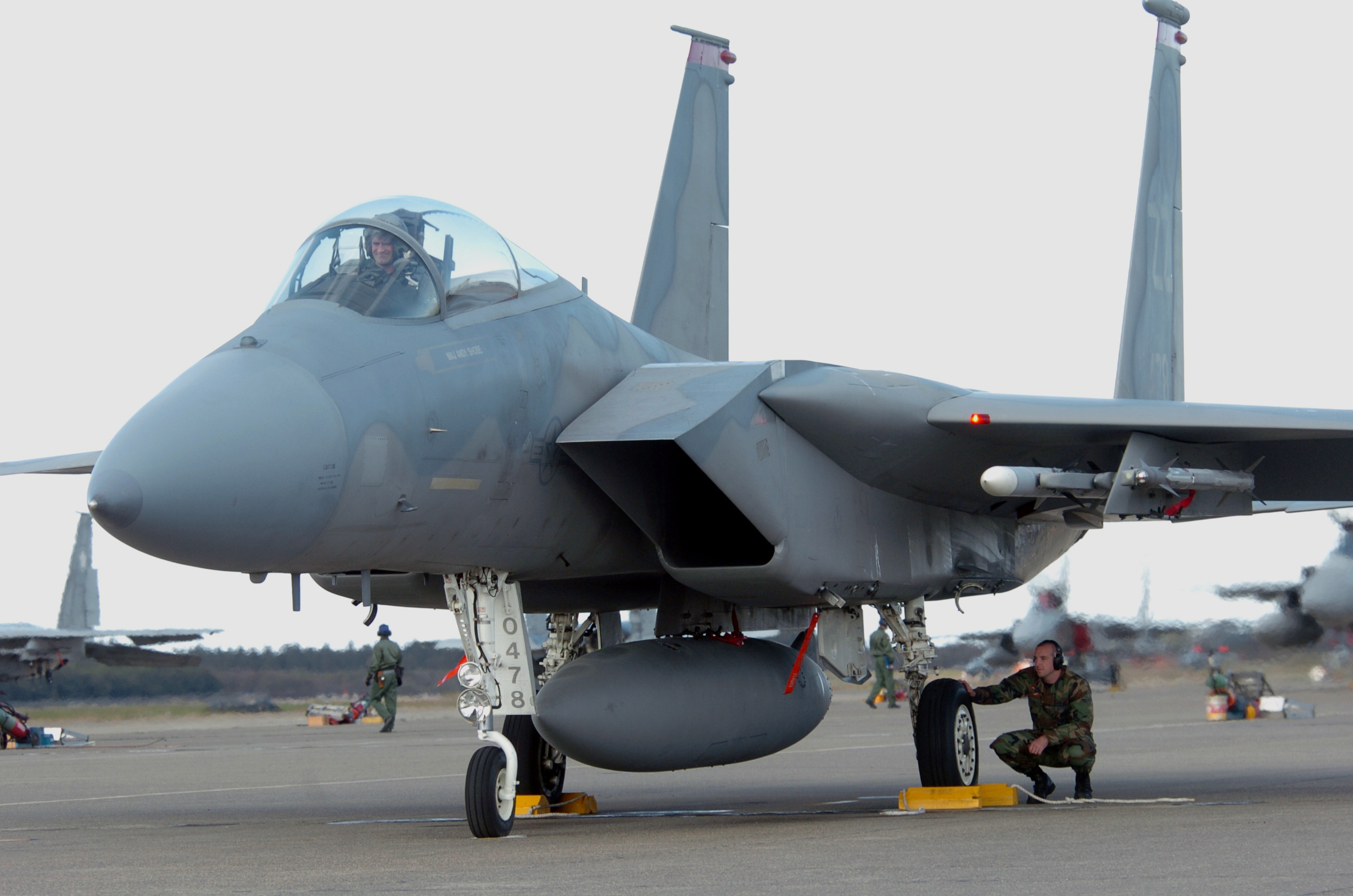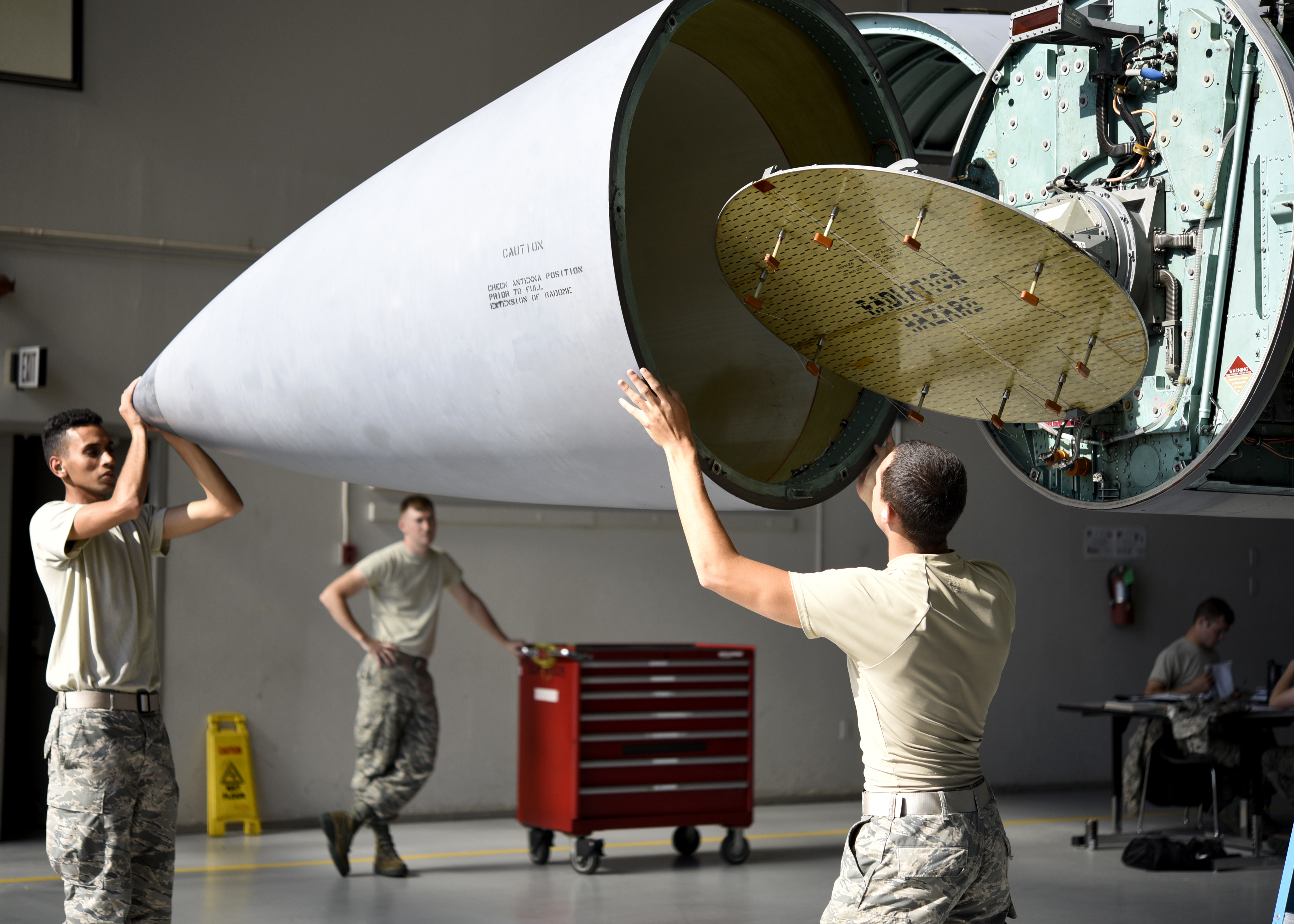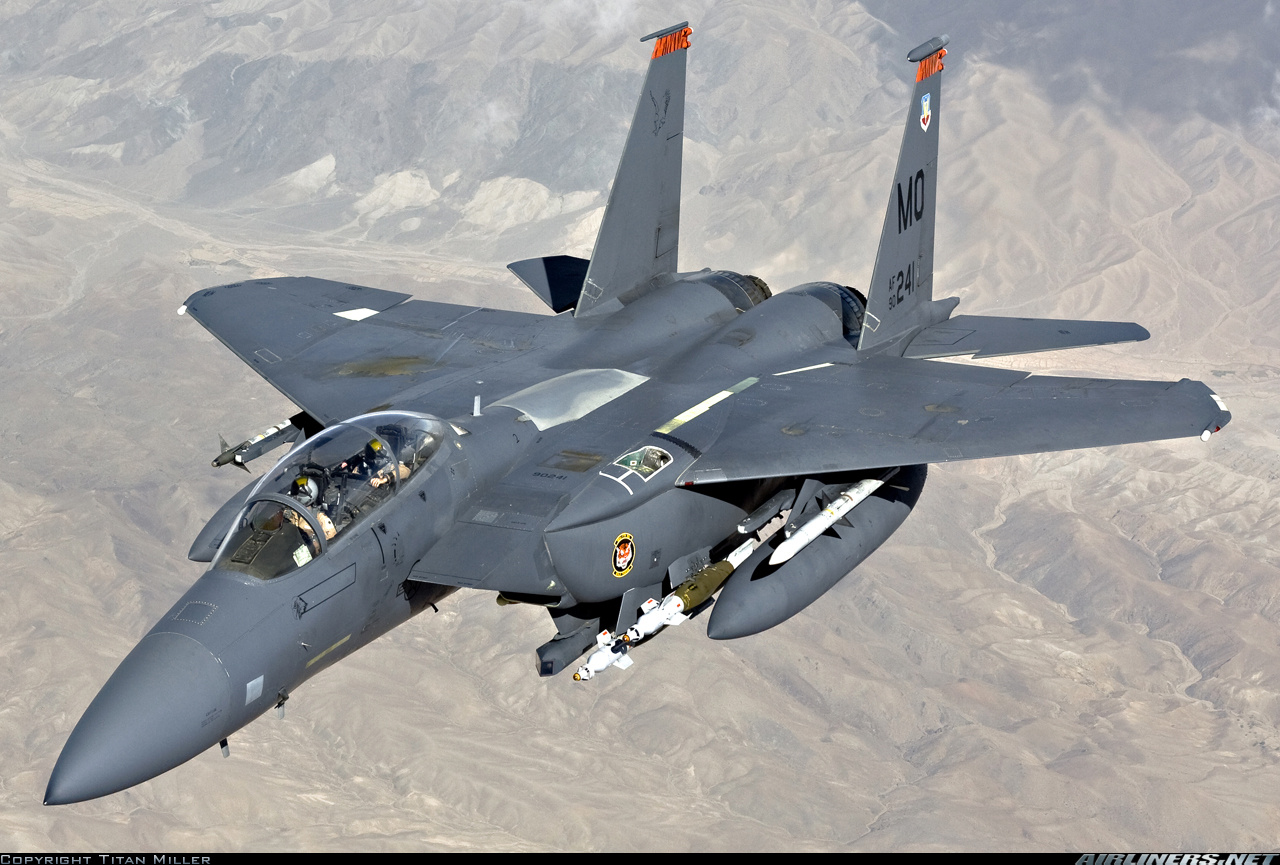- Yes
- No
History
The first of its kind, F-15A Eagle, was a successful air superiority fighter. Of course there were some shortcomings, but most could be supplemented by measures over the next few years. One of them was the demand for more fuel, so the Production Eagle Package 2000 program began in 1977. Among with other changes, it eventually became F-15C.
The next step for F-15C was the Multi Stage Improvement Program (MSIP). Initially MSIP programs were planned in two ways, the MSIP I for F-15A/B and MSIP II for F-15C/D. However, MSIP I was canceled because it was considered uneconomical, leaving only MSIP II. By the MSIP II program, F-15C got new color display, Tactical Electronic Warfare System (TEWS) composed of AN/ALQ-135 ICS, AN/ALR-56C RWR, AN/ALQ-128 EWWS, AN/ALE-40/45 CMD, provisions for AMRAAM.
The MSIP II configured F-15C was first evaluated in December 1984, and MSIP changes were applied to production aircrafts from June 1985. The F-15C MSIP II completely overwhelmed Iraqi fighters during Operation Desert Storm, and has since been upgraded to continue its life. As of 2023, USAF still operates 86 F-15Cs.
Design
Airframe, Engine

The airframe of the F-15C is an improved one, based on that of the F-15A. Thanks to the added fuel tanks, F-15C could hold about 2,000 lb (907 kg) more fuel internally. Due to the increased weight, some parts of the airframe were strengthened to handle extra weight. The main gear wheels were changed too.
To boost range and endurance, the provisions for conformal fuel tanks (CFTs) became standard. F-15C’s CFTs with missile launcher weighs 2,349 lb (1,065 kg) and could hold 9,631 lb (4,368 kg) of fuel. It is also drag efficient, since drag number of two CFTs (4.0) are less than that of the single 610 gallon external tank (5.5 or 12.2, depends on stations).
As like F-15A, F-15C used F100-PW-100 engine initially. The early F100 engine were powerful enough, but also had a reliability, maintenance, service life issues. These problems were solved in F100-PW-200 engine, by digital electronic engine control. This results in 300 lb (136 kg) and 400 lb (180 kg) reduction in each dry and afterburning thrust, while dynamic thrust was improved throughout most of the flight envelope due to more efficient power and fuel distribution. Though the PW-220 engine became available in 1986, the improvements were applied to the earlier PW-100 engine. These upgraded PW-100 engine is renamed to PW-220E.
Specifications of the AN/APG-63 PSP radar
Antenna gimbal limit: ±60° (both azimuth and elevation)
Scale:
- Range: 10/20/40/80/160 NM (19/37/74/148/296 km)
- Azimuth: 20/60/120°
Elevation scan pattern: 1/2/4/6/8 bar
Beamwidth: 2.5°
Scan rate: 70°/s
Frequency: I band
Waveform: HPRF, MPRF
Radar mode:
- Long Range Search (SRC PD)
- Effective range: ~ 80 NM (150 km)
- Waveform: HPRF, MPRF, Interleaved - Short Range Search (SRC PD)
- Range scale: 10/20/40 NM (19/37/74 km)
- Waveform: MPRF - Velocity Search (SRC PDV HDN)
- Velocity scale: 80 ~ 1,800 kts (150 ~ 3,330 km/h)
- Waveform: HPRF - Raid Assessment
- Range scale: 35 NM (65 km)
- Max No. of target tracks: 4
- Waveform: MPRF - Single Target Track (TRK PD)
- Flood
- Effective range: ~ 8 NM (15 km) - Boresight (ACM PD)
- Range: 500 ft ~ 10 NM (10 ~ 19 km)
- Scan area: 4° × 4°
- Waveform: MPRF - Vertical Scan (ACM PD)
- Range: 500 ft ~ 10 NM (10 ~ 19 km)
- Scan area: 7.5° in azimuth, +5° ~ +45° in elevation (7.5° × 40°)
- Waveform: MPRF
F-15C uses AN/APG-63 PSP, the upgraded AN/APG-63 with programmable signal processor. The major differences between original APG-63 and APG-63 PSP is the addition of Raid Assessment mode for break out closely spread multiple targets, and superseded non-doppler mode. Original Pulse Search (PS) mode of APG-63 utilized low PRF waveform for look-up condition, but it was changed to medium PRF in APG-63 PSP.
Another notable feature is the Non-Cooperative Target Recognition (NCTR), which added to F-15C by MSIP II program. With the NCTR, the pilot could recognize type of enemy aircraft by radar reflection of engine fan blades. The effectiveness of NCTR proved during the Gulf War, because the rules of the engagement required at least two methods to identifying targets. The F-15C MSIP was the only aircraft with NCTR feature at that time, so Eagle drivers could easily identify target by AWACS and built-in NCTR.
The final 43 production F-15C/Ds were fitted with more capable AN/APG-70 radar. Later the AN/APG-63(V)1, which is even more capable than AN/APG-70, was introduced and retrofitted to legacy F-15C/Ds.
Armament, Countermeasures

The F-15C has a built-in M61A1 20 mm gatling gun with 940 rounds of ammo, and capable of carry four AIM-9 Sidewinder and AIM-7 Sparrow missiles each. F-15C acquired provisions for AIM-120 AMRAAM by MSIP II program, and the missile itself became available in 1991. The AMRAAM is lighter and smaller than Sparrow, so it could be loaded under wing using a LAU-128 launcher like a Sidewinder.
Because the F-15C is an air superiority fighter, its air-to-ground capability is limited to carrying and releasing some unguided bombs. In fact, even that is extremely rare in the U.S. Air Force.
Along with AMRAAM, the most important feature of MSIP program is addition of AN/ALE-40/45 countermeasure dispenser (CMD). The F-15C MSIP II has eight CMDs for 240 countermeasures.
F-15 and LAU-128B/A




In addition to the internal countermeasures, the LAU-128B/A launcher rail with AN/ALE-58 BOL dispenser provides an additional 160 countermeasures per unit.
Specifications
Crew: 1
Length: 63.75 ft (19.43 m)
Wingspan: 42.81 ft (13.05 m)
Height: 18.45 (5.62 m)
Wing area: 608 sq ft (56.48 m²)
Aspect ratio: 3.01
Weight:
- Operating weight (including pilot, oil, unusable fuel):
- 29,000 lb (13,154 kg) w/o CFTs
- 31,000 lb (14,061 kg) with CFTs
- Gross weight (full internal fuel, centerline fuel tank, 4× LAU-114 launcher):
- 48,500 lb (22,000 kg) w/o CFTs
- 60,500 lb (27,442 kg) with CFTs
- Maximum takeoff weight: 68,000 lb (30,844 kg)
Fuel (JP-8):
- Internal: 13,850 lb (6,282 kg)
- Conformal: 10,100 lb (4,581 kg) with 2× CFTs
- External: 12,300 lb (5,579 kg) with 3× 610 gallon fuel tanks
Powerplant: 2× F100-PW-220/220E
- Intermediate thrust (static): 14,370 lb (63.9 kN)
- Maximum thrust (static): 23,450 lb (104.3 kN)
Performances:
- Maximum speed (50% fuel, clean):
- @ Sea Level: Mach 1.2
- @ 35,000 ft (10.6 km): Mach 2.2
- Altitude: 65,000 ft (19.8 km)
- Time to climb from sea level (50% fuel, 4× AIM-7, 4× LAU-114):
- To 10,000 ft (3 km): 21 seconds
- To 20,000 ft (6 km): 51 seconds
- To 30,000 ft (9 km): 78 seconds
- Time to accelerate from Mach 0.46 (altitude 10,000 ft, 60% fuel, clean):
- To Mach 0.6: 5 seconds
- To Mach 0.8: 13.5 seconds
- To Mach 1.0: 21.5 seconds
- To Mach 1.2: 39 seconds
- Maximum instantaneous turn rate (altitude 10,000 ft, 50% fuel, 4× AIM-7): 28.5°/s (at 305 KCAS)
- Turn radius at maximum instantaneous turn rate: 1,660 ft (0.51 km)
- Maximum sustained turn rate (50% fuel, clean):
- @ Sea Level: 20.5°/s (at 475 KCAS)
- @ 10,000 ft (3 km): 16.5°/s (at 505 KCAS)
- @ 20,000 ft (6 km): 12.25°/s (at 415 KCAS)
- @ 30,000 ft (9 km): 8.5°/s (at 340 KCAS)
- Turn radius at maximum sustained turn rate:
- @ Sea Level: 2,242 ft (0.68 km)
- @ 10,000 ft (3 km): 3,344 ft (1.02 km)
- @ 20,000 ft (6 km): 4,267 ft (1.3 km)
- @ 30,000 ft (9 km): 5,921 ft (1.8 km)
- Maximum allowable load factor: -3.0 ~ +9.0 g
- Takeoff distance: 900 ft (0.27 km)
- Landing distance: 2,500 ft (0.76 km)
- Minimum control speed: 100 kt (185 km/h)
Armament:
- Hardpoints: 7 total (2× under wing, 5× under fuselage)
- Gun: 1× M61A1 20 mm gun (940 rounds)
- Air-to-air missiles:
- AIM-9E/J/L/M/X Sidewinder (X: since 2003)
- AIM-7F/M Sparrow
- AIM-120A/B/C-5/D AMRAAM (A: since 1991, B: since 1994, C-5: since 2000, D: since 2007)
- Unguided bombs:
- Mk 82/84 general-purpose bomb
- Mk 82 Snakeye high-drag bomb
Avionics:
- Radar:
- AN/APG-63 PSP
- AN/APG-70 (only for the last 43 production aircraft)
- AN/APG-63(V)1 (replaced APG-63 PSP and APG-70 since 2001)
- RWR: AN/ALR-56C
- HMD: JHMCS (since 2005)
- Countermeasures:
- Internal: 8× AN/ALE-40/45 (240 total)
- External: 4× AN/ALE-58 (built in LAU-128B/A launcher; 640 total)
Sources
- Aeroguide 19 - McDonnell Douglas F-15A/B/C/D Eagle by Roger Chesneau
- AFSC 2A3X4X Fighter Aircraft Integrated Avionics A-10 / F-15 / F-16 / U-2 Career Field Education and Traning Plan by United States Air Force (Releasability: There are no releasability restrictions on this publication)
- AN/ALE-58(V) BOL EW Dispenser System from Military Electronics Briefing
- An Illustrated Guide to Modern Fighter Combat (1987) by Mike Spick
- Air-to-Air Radar Modes for the CP-140 Maritime Patrol Aircraft by Loraine L. Campbell
- Crowood Aviation Series: McDonnell Douglas F-15 Eagle by Peter E. Davies and Tony Thornborough
- Eagle Talk Vol.II from McDonnell Douglas
- Eagle Talk Vol.III from McDonnell Douglas
- F-15 Armament Handbook from McDonnell Douglas
- F-15 Eagle at War by Tyson V. Rininger
- F-15 Eagle in Action: Aircraft Number 183 by Al Adcock
- F-15 Eagle in detail & scale by Bert Kinzey
- F-15イーグル Flight Manual & Air-to-Air Weapon Delivery Manual 日本語訳永久保存版 by 青木謙知
- Fighter Wing: A Guided Tour of an Air Force Combat Wing by Tom Clancy
- LAU-128 from Marvin Engineering Company
- McDonnell Douglas F-15 Eagle: Supreme Heavy-Weight Fighter by Dennis R. Jenkins
- Modern Military Aircraft: Eagle by Lou Drendel
- Osprey Combat Aircraft Series: F-15 Eagle by Mike Spick
- United States Air Force Air Power Yearbook 2018 from Key Publishing Ltd
- Walk Around No.28: F-15 Eagle by Lou Drendel
- WarbirdTech Series Volume 9: McDonnell Douglas F-15 Eagle by Dennis R. Jenkins



